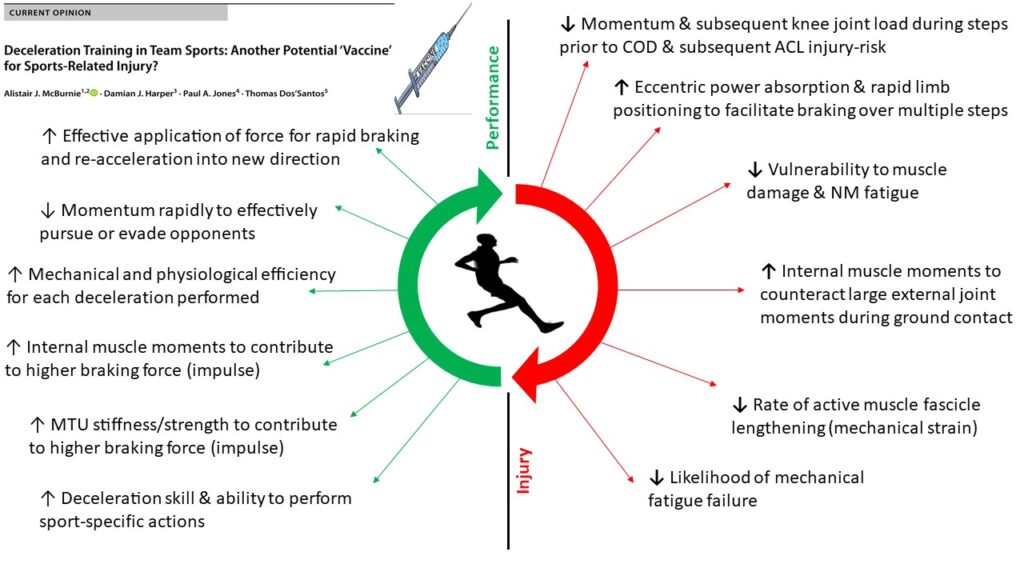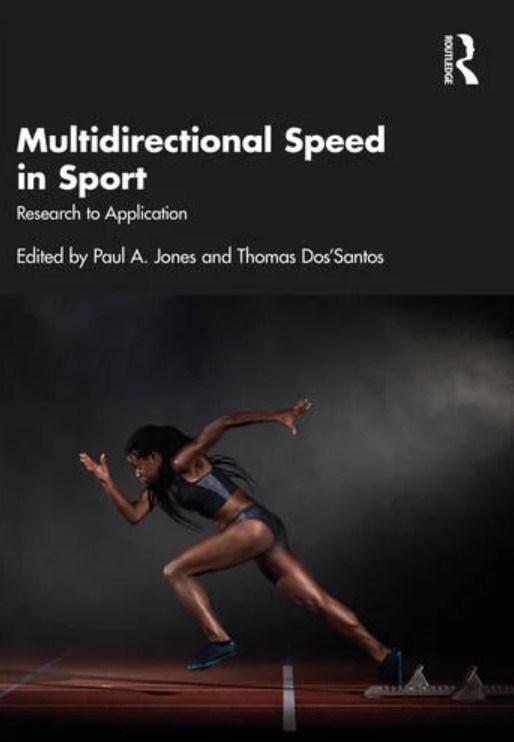In this short blog, I wanted to provide a quick overview of the chapter I wrote titled ‘Deceleration in Sport: Incidence, Demands and Implications for Training?’ which features in the book edited by Paul Jones and Tom Dos Santos titled ‘Multi-Directional Speed in Sport: Research to Application’. In this chapter and this blog ‘deceleration’ is referring to whole body horizontal deceleration that occurs prior to the many changes of direction that players perform in multi-directional sports. As I highlight in the opening paragraph of the chapter, deceleration has been largely overlooked in comparison to acceleration and maximum velocity sprint running capabilities, and this was the first chapter in the myriad of sports performance books purely devoted to deceleration!
Deceleration is a highly complex movement skill requiring athletes to generate and tolerate high impact braking forces. The chapter commences by highlighting a definition of deceleration ability, which is a “players ability to proficiently reduce whole body momentum, within the constraints, and in accordance with the specific objectives of the task (i.e., braking force control), whilst skilfully attenuating and distributing the forces associated with braking (i.e., braking force attenuation)” (Harper et al., 2022). In my previous blog I go into more detail of the two key components of horizontal deceleration ability highlighted in this definition, including:
1) Braking Force Control
2) Braking Force Attenuation
The chapter then covers the incidence of decelerations in some of the most popular multi-directional sports, providing an overview of the frequency of high-intensity decelerations compared to accelerations. Interestingly, this latest data (mainly from GPS devices) continues to show greater frequency of high-intensity decelerations compared to accelerations in most multi-directional sports, which was a trend first reported in a review paper published by myself, Chris Carling and John Kiely back in 2019 (Harper et al., 2019). Understanding the demands of deceleration in competitive matches is a very important area of future work. There is a need to better understanding the context to why high-intensity decelerations are occurring, and opportunity for advancements in technology to provide more in-depth insights into the unique biomechanical and physiological demands of deceleration and braking.
Insights into the biomechanical and physiological demands of deceleration are discussed, with the performance and injury-risk reduction implications summarised from our publication titled ‘deceleration training in team sports: another potential ‘vaccine’ for sports-related injury?’ (McBurnie et al., 2022). Figure 1 illustrates the potential performance and injury-risk reduction implications of deceleration training, highlighting why deceleration is so important for players involved in multi-directional sports.

Figure 1. Potential performance and injury-risk reduction (‘vaccine’) implications from
deceleration training in multi-directional sports.
To ensure players are prepared for these demands the chapter concludes by highlighting the physical and technical determinants of deceleration and the training solutions that could be implemented to target improvements in an athlete’s horizontal deceleration ability. The chapter proposes the use of a braking performance framework (BPF) that could be used by practitioners to help guide selection of training methods and exercises to enhance an athlete’s horizontal deceleration ability (more on this in future blogs). Finally, the chapter encourages future research into the effectiveness of training interventions that can be used to enhance player deceleration ability and reduce susceptibility to injury and fatigue that can be caused from deceleration activities.
The book ‘Multidirectional Speed in Sport: Research to Application’ can be purchased here.
Hope you enjoy the read!


References
Harper, D.J. (2023). Chapter 5: Deceleration in sport: Incidence, demands and implications for training? In: Jones, P.A. & Dos’Santos, T. Multi-Directional Speed in Sport: Research to Application. (pp74-103). Routledge.
Harper, D. J., Carling, C., & Kiely, J. (2019). High-intensity acceleration and deceleration demands in elite team sports competitive match play: A systematic review and meta-analysis of observational studies. Sports Medicine, 49(12), 1923–1947.
Harper, D. J., McBurnie, A. J., Santos, T. D., Eriksrud, O., Evans, M., Cohen, D. D., Rhodes, D., Carling, C., & Kiely, J. (2022). Biomechanical and neuromuscular performance requirements of horizontal deceleration: A review with implications for random intermittent multi-directional sports. Sports Medicine, 52(10), 2321–2354.
McBurnie, A. J., Harper, D. J., Jones, P. A., & Dos’Santos, T. (2022). Deceleration Training in Team Sports: Another Potential “Vaccine” for Sports-Related Injury? Sports Medicine (Auckland, N.Z.), 52(1), 1–12.
